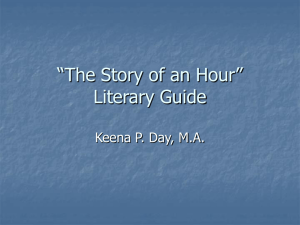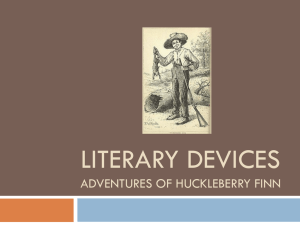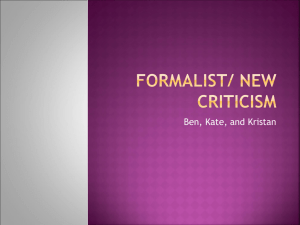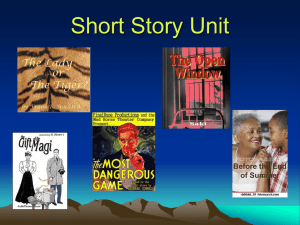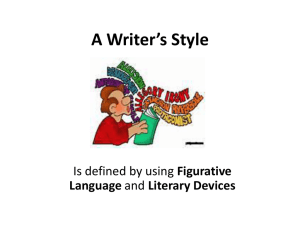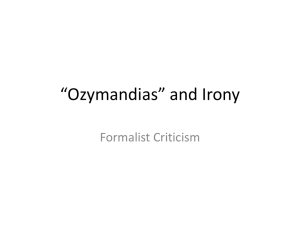Journal Prompts.CC
advertisement
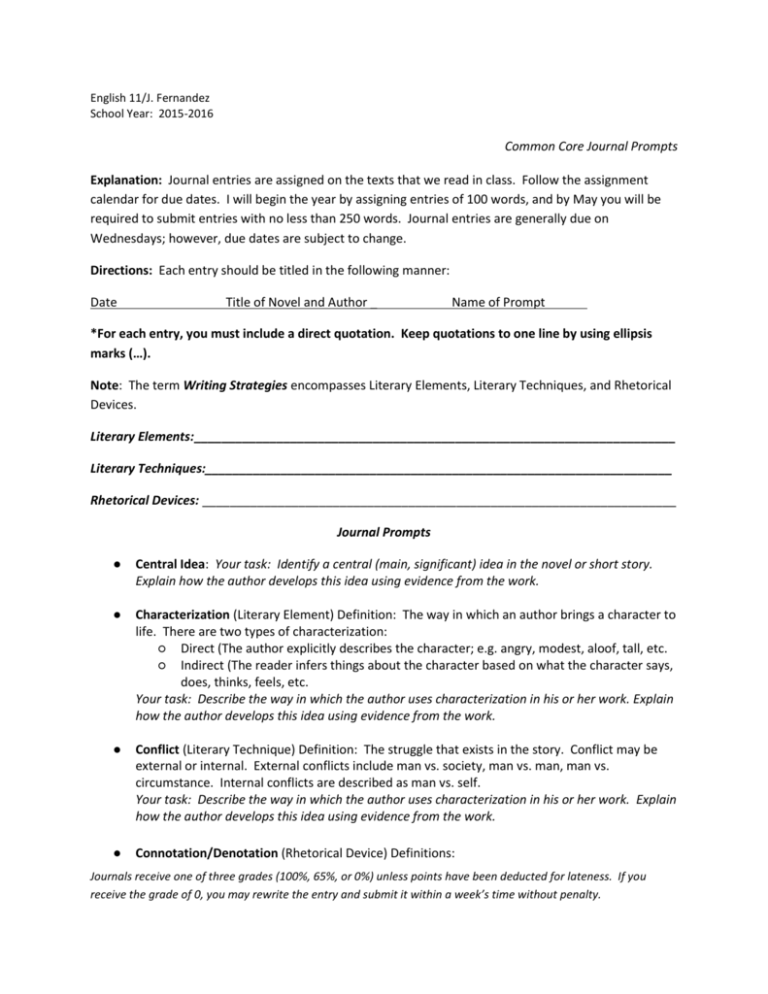
English 11/J. Fernandez School Year: 2015-2016 Common Core Journal Prompts Explanation: Journal entries are assigned on the texts that we read in class. Follow the assignment calendar for due dates. I will begin the year by assigning entries of 100 words, and by May you will be required to submit entries with no less than 250 words. Journal entries are generally due on Wednesdays; however, due dates are subject to change. Directions: Each entry should be titled in the following manner: Date Title of Novel and Author _ Name of Prompt *For each entry, you must include a direct quotation. Keep quotations to one line by using ellipsis marks (…). Note: The term Writing Strategies encompasses Literary Elements, Literary Techniques, and Rhetorical Devices. Literary Elements:______________________________________________________________________ Literary Techniques:____________________________________________________________________ Rhetorical Devices: _____________________________________________________________________ Journal Prompts ● Central Idea: Your task: Identify a central (main, significant) idea in the novel or short story. Explain how the author develops this idea using evidence from the work. ● Characterization (Literary Element) Definition: The way in which an author brings a character to life. There are two types of characterization: ○ Direct (The author explicitly describes the character; e.g. angry, modest, aloof, tall, etc. ○ Indirect (The reader infers things about the character based on what the character says, does, thinks, feels, etc. Your task: Describe the way in which the author uses characterization in his or her work. Explain how the author develops this idea using evidence from the work. ● Conflict (Literary Technique) Definition: The struggle that exists in the story. Conflict may be external or internal. External conflicts include man vs. society, man vs. man, man vs. circumstance. Internal conflicts are described as man vs. self. Your task: Describe the way in which the author uses characterization in his or her work. Explain how the author develops this idea using evidence from the work. ● Connotation/Denotation (Rhetorical Device) Definitions: Journals receive one of three grades (100%, 65%, or 0%) unless points have been deducted for lateness. If you receive the grade of 0, you may rewrite the entry and submit it within a week’s time without penalty. English 11/J. Fernandez School Year: 2015-2016 Common Core Journal Prompts ○ Connotation refers to the associations that are connected to a certain word or the emotional suggestions related to that word. The connotative meanings of a word exist together with the denotative meanings. The connotations for the word snake could include evil or danger. ○ Denotation refers to the literal meaning of a word aka the "dictionary definition."¨ For example, if you look up the word snake in a dictionary, you will discover that one of its denotative meanings is "any of numerous scaly, legless, sometimes venomous reptiles having a long, tapering, cylindrical body and found in most tropical and temperate regions." Your task: Describe the way in which the author uses either connotation or denotation in his or her work. Be sure to provide evidence from the work to justify your analysis. ● Figurative Language: Definition: (Cliché, Simile, Metaphor, Personification, Imagery, Hyperbole, etc.) Your task: Describe the way in which the author makes use one of the following types of figurative language. Explain how the author develops this idea using evidence from the work. ● Irony: Definition: An implied discrepancy between what is said and what is meant: ○ Verbal Irony is when an author says one thing and means another. ○ Dramatic Irony is when an audience perceives something that a character in the literature does not know. ○ Situational Irony is a discrepancy between the expected result and the actual result. Your task: Describe the way in which the author makes use of situational, verbal, or dramatic irony. Explain how the author develops this idea using evidence from the work. ● Point-of-View: Definition: the perspective from which the narrator tells the story. Your task: Describe the point-of-view used in the novel. What does the particular vantage point (1st person, 3rd person, etc.) add or take away from the writing? Remember, point-of-view IS NOT the author’s opinion. Explain how the author develops this idea using evidence from the work. ● Symbolism: Definition: The use of specific objects or images to represent ideas. A symbol must be something tangible or visible, while the idea it symbolizes must be something abstract or universal. In other words, a symbol must be something you can hold in your hand or draw a picture of, while the idea it symbolizes must be something you can’t hold in your hands or draw a picture of. Your task: Describe the way in which the author uses symbolism in the novel. Explain how the author develops this idea using evidence from the work. ● Structure: Definition: The way an author arranges the plot of a story. Your task: Describe the way in which the author uses makes use of structure in the novel. Journals receive one of three grades (100%, 65%, or 0%) unless points have been deducted for lateness. If you receive the grade of 0, you may rewrite the entry and submit it within a week’s time without penalty. English 11/J. Fernandez School Year: 2015-2016 Common Core Journal Prompts Explain how the author develops this idea using evidence from the work. ● Theme: Definition: A universal message conveyed by the author. Your task: Describe one theme that the author has expressed in the novel. Explain how the author develops this idea using evidence from the work. Journals receive one of three grades (100%, 65%, or 0%) unless points have been deducted for lateness. If you receive the grade of 0, you may rewrite the entry and submit it within a week’s time without penalty.

